The Method of Fundamental Solutions for Three-Dimensional Nonlinear Free Surface Flows Using the Iterative Scheme
Abstract
1. Introduction
2. The Governing Equation
3. The Method of Fundamental Solutions
3.1. The Fundamental Solution of the Laplace Equation
3.2. The Relaxation Scheme
4. Validation Examples
4.1. Analysis of Three-Dimensional Seepage Flow Problem
4.2. Analysis of Laminar Flow Around a Cylinder in Three Dimensions
5. Application of the Proposed Method
5.1. Flow Through a Rectangular Dam in Three Dimensions
5.2. Flow Through a Trapezoidal Dam in Three Dimensions
5.3. Flow Through an Earth Dam in Three Dimensions
6. Discussion
7. Conclusions
- The study on solving three-dimensional free surface flow problems is still limited to the conventional mesh-based method. This study presents a pioneering work using a novel moving boundary-type meshless method based on the MFS capable of solving three-dimensional free surface flow problems over arbitrary geometries. Compared to conventional mesh-based methods, the proposed method is relatively simple because the points are collocated only on the problem boundary.
- With the advantage of the boundary-type meshless method, only the collocation points on the moving surface have to be renewed during iteration for the computation of the location of the three-dimensional nonlinear free surface. It avoids the most difficult task for handling the three-dimensional geometric complexity.
- The validation examples demonstrate that the MAE from the computed results can achieve the accuracy with the order of 10−12. It is significant that our method may yield highly accurate results. The effectiveness and ease of use for solving three-dimensional nonlinear free surface flows are also revealed.
- The appearance of layered soils is often found in free surface flow problems such as the zoned embankment type dam. The anisotropic nature of layered soils is usually difficult to solve using the MFS. Further research is recommended to solve free surface flow problems in layered heterogeneous soils. It is suggested that the domain decomposition method may be an alternative to integrate with the MFS to deal with these problems in layered heterogeneous soils.
- Furthermore, the transient free surface flow problem may be a great challenge for the MFS. Several studies have been found to solve the transient heat equation using the MFS. Since the governing equation of the transient free surface flow and the transient heat conduction problems are identical, it is recommended that further research may be considered to apply the MFS for solving transient free surface flow problems.
Author Contributions
Funding
Acknowledgments
Conflicts of Interest
References
- Xiao, J.-E.; Ku, C.-Y.; Liu, C.-Y.; Fan, C.-M.; Yeih, W. On solving free surface problems in layered soil using the method of fundamental solutions. Eng. Anal. Bound. Elem. 2017, 83, 96–106. [Google Scholar]
- Sun, G.; Lin, S.; Jiang, W.; Yang, Y. A simplified solution for calculating the phreatic line and slope stability during a sudden drawdown of the reservoir water level. Geofluids 2018, 2018. [Google Scholar] [CrossRef]
- Cryer, C.-W. On the approximate solution of free boundary problems using finite differences. J. ACM 1970, 17, 397–411. [Google Scholar] [CrossRef]
- Taylor, R.-L.; Brown, C.-B. Darcy flow solutions with a free surface. ASCE 1967, 93, 25–33. [Google Scholar]
- Finn, W.D.L. Finite-element analysis of seepage through dams. ASCE 1967, 93, 41–48. [Google Scholar]
- Neuman, S.-P.; Witherspoon, P.-A. Finite element method of analyzing steady seepage with a free surface. Water Resour. Res. 1970, 6, 889–897. [Google Scholar] [CrossRef]
- Bathe, K.-J.; Khoshgoftaar, M.-R. Finite element free surface seepage analysis without mesh iteration. Int. J. Numer. Anal. Met. 1979, 3, 13–22. [Google Scholar] [CrossRef]
- Kikuchi, N. An analysis of the variational inequalities of seepage flow by finite-element methods. Q. Appl. Math. 1977, 35, 149–163. [Google Scholar] [CrossRef]
- Alt, H.-W. Numerical solution of steady-state porous flow free boundary problems. Numer. Math. 1980, 36, 73–98. [Google Scholar] [CrossRef]
- Oden, J.-T.; Kikuchi, N. Recent advances: Theory of variational inequalities with applications to problems of flow through porous media. Int. J. Eng. Sci. 1980, 18, 1173–1284. [Google Scholar] [CrossRef]
- Desai, C.-S.; Li, G.-C. A residual flow procedure and application for free surface flow in porous media. Adv. Water Resour. 1983, 6, 27–35. [Google Scholar] [CrossRef]
- Westbrook, D.-R. Analysis of inequalities and residual flow procedures and an iterative scheme for free surface seepage. Int. J. Numer. Meth. Eng. 1985, 21, 1791–1802. [Google Scholar] [CrossRef]
- Brezis, H.; Kinderlehrer, D.; Stampacchia, G. Sur une Nouvelle Formulation du Probleme de L’ecoulement a Travers une Digue; Serie A; C. R. Academie des Sciences: Paris, France, 1978. [Google Scholar]
- Cheng, Y.-M.; Tsui, Y. An efficient method for the free surface seepage flow problems. Comput. Geotech. 1993, 15, 47–62. [Google Scholar] [CrossRef]
- Ji, C.-N.; Wang, Y.-Z.; Shi, Y. Application of modified EP method in steady seepage analysis. Comput. Geotech. 2005, 32, 27–35. [Google Scholar] [CrossRef]
- Fukuchi, T. Numerical analyses of steady-state seepage problems using the interpolation finite difference method. Soils Found. 2016, 56, 608–626. [Google Scholar] [CrossRef]
- Wu, C.-P.; Lin, C.-H.; Chiou, Y.-J. Multi-region boundary element analysis of unconfined seepage problems in excavations. Comput. Geotech. 1996, 19, 75–96. [Google Scholar] [CrossRef]
- Tsay, R.-J.; Chiou, Y.-J.; Cheng, T.-C. Boundary element analysis for free surface of seepage in earth dams. J. Chin. Inst. Eng. 1997, 20, 95–101. [Google Scholar] [CrossRef]
- Neuman, S.-P.; Witherspoon, P.-A. Variational principles confined and unconfined flow of ground water. Water Resour. Res. 1970, 6, 1376–1382. [Google Scholar] [CrossRef]
- Athani, S.-S.; Shivamanth; Solanki, C.-H.; Dodagoudar, G.-R. Seepage and stability analyses of earth dam using finite element method. Aquat. Procedia 2015, 4, 876–883. [Google Scholar] [CrossRef]
- Ahmed, A.-A. Stochastic analysis of free surface flow through earth dams. Comput. Geotech. 2009, 36, 1186–1190. [Google Scholar] [CrossRef]
- Xiao, J.-E.; Ku, C.-Y.; Huang, W.-P.; Su, Y.; Tsai, Y.-H. A novel hybrid boundary-type meshless method for solving heat conduction problems in layered materials. Appl. Sci. 2018, 8, 1887. [Google Scholar] [CrossRef]
- Liu, C.-S. Improving the ill-conditioning of the method of fundamental solutions for 2D Laplace equation. CMES-Comput. Model. Eng. 2009, 851, 1–17. [Google Scholar]
- Tsai, C.-C.; Young, D.-L. Using the method of fundamental solutions for obtaining exponentially convergent Helmholtz eigensolutions. CMES-Comput. Model. Eng. 2013, 94, 175–205. [Google Scholar]
- Liu, C.-S. The method of fundamental solutions for solving the backward heat conduction problem with conditioning by a new post-conditioner. Numer. Heat Transf. B-Fund. 2011, 60, 57–72. [Google Scholar] [CrossRef]
- Fan, C.-M.; Chen, C.-S.; Monroe, J. The method of fundamental solutions for solving convection-diffusion equations with variable coefficients. Adv. Appl. Math. Mech. 2009, 1, 215–230. [Google Scholar]
- Li, M.; Chen, C.-S.; Karageorghis, A. The MFS for the solution of harmonic boundary value problems with non-harmonic boundary conditions. Comput. Math. Appl. 2013, 66, 2400–2424. [Google Scholar] [CrossRef]
- Kupradze, V.-D.; Aleksidze, M.-A. The method of functional equations for the approximate solution of certain boundary value problems. USSR Comput. Math. Math. Phys. 1964, 4, 82–126. [Google Scholar] [CrossRef]
- Young, D.-L.; Chiu, C.-L.; Fan, C.-M.; Tsai, C.-C.; Lin, Y.-C. Method of fundamental solutions for multidimensional Stokes equations by the dual-potential formulation. Eur. J. Mech. B/Fluids 2006, 25, 877–893. [Google Scholar] [CrossRef]
- Marin, L. Treatment of singularities in the method of fundamental solutions for two-dimensional Helmholtz-type equations. Appl. Math. Model. 2010, 34, 1615–1633. [Google Scholar] [CrossRef]
- Bello, N.; Alkali, A.-J.; Roko, A. A fixed point iterative method for the solution of two-point boundary value problems for a second order differential equations. Alexandria Eng. J. 2017, 57, 2515–2520. [Google Scholar] [CrossRef]
- Huang, N.; Ma, C. Convergence analysis and numerical study of a fixed-point iterative method for solving systems of nonlinear equations. Sci. World J. 2014, 2014, 1–10. [Google Scholar] [CrossRef]
- Kumar, M.; Singh, A.-K.; Srivastava, A. Various Newton-type iterative methods for solving nonlinear equations. J. Egypt. Math. Soc. 2013, 21, 334–339. [Google Scholar] [CrossRef]
- Jin, S.; Xin, Z. The relaxation schemes for systems of conservation laws in arbitrary space dimensions. Commun. Pure Appl. Math. 1995, 48, 235–276. [Google Scholar] [CrossRef]
- Aregba-Driollet, D.; Natalini, R. Convergence of relaxation schemes for conservation laws. Appl. Anal. 1996, 61, 163–193. [Google Scholar] [CrossRef]
- Aregba-Driollet, D.; Natalini, R. Discrete kinetic schemes for multidimensional systems of conservation laws. Siam J. Numer. Anal. 2000, 37, 1973–2004. [Google Scholar] [CrossRef]
- Mehl, S. Use of Picard and Newton iteration for solving nonlinear groundwater flow equations. Groundwater 2006, 44, 583–594. [Google Scholar] [CrossRef] [PubMed]
- Ku, C.-Y.; Kuo, C.-L.; Fan, C.-M.; Liu, C.-S.; Guan, P.-C. Numerical solution of three-dimensional Laplacian problems using the multiple scale Trefftz method. Eng. Anal. Bound. Elem. 2015, 50, 157–168. [Google Scholar] [CrossRef]
- Chen, C.-S.; Karageorghis, A.; Li, Y. On choosing the location of the sources in the MFS. Numer. Algorithms 2016, 72, 107–130. [Google Scholar] [CrossRef]
- Aitchison, J. Numerical Treatment of a Singularity in a Free Boundary Problem; Royal Society of London: London, UK, 1972; pp. 573–580. [Google Scholar]
- Chen, J.-T.; Hsiao, C.-C.; Chiu, Y.-P.; Lee, Y.-T. Study of free surface seepage problems using hypersingular equations. Comm. Numer. Meth. Eng. 2007, 23, 755–769. [Google Scholar] [CrossRef]
- Bardet, J.-P.; Tobita, T. A practical method for solving free-surface seepage problems. Comput. Geotech. 2002, 29, 451–475. [Google Scholar] [CrossRef]
- Rafiezadeh, K.; Ataie-Ashtiani, B. Transient free-surface seepage in three-dimensional general anisotropic media by BEM. Eng. Anal. Bound. Elem. 2014, 46, 51–66. [Google Scholar] [CrossRef]
- Lacy, S.-J.; Prevost, J.-H. Flow through porous media: A procedure for locating the free surface. Int. J. Numer. Anal. Met. 1987, 11, 585–601. [Google Scholar] [CrossRef]
- Bazyar, M.-H.; Graili, A. A practical and efficient numerical scheme for the analysis of steady state unconfined seepage flows. Int. J. Numer. Anal. Met. 2011, 36, 1793–1812. [Google Scholar] [CrossRef]
- Kazemzadeh-Parsi, M.-J.; Daneshmand, F. Unconfined seepage analysis in earth dams using smoothed fixed grid finite element method. Int. J. Numer. Anal. Met. 2011, 36, 780–797. [Google Scholar] [CrossRef]
- Bazyar, M.-H.; Talebi, A. Locating the free surface flow in porous media using the scaled boundary finite-element method. Int. J. Chem. Eng. Appl. 2014, 5, 155–160. [Google Scholar] [CrossRef]
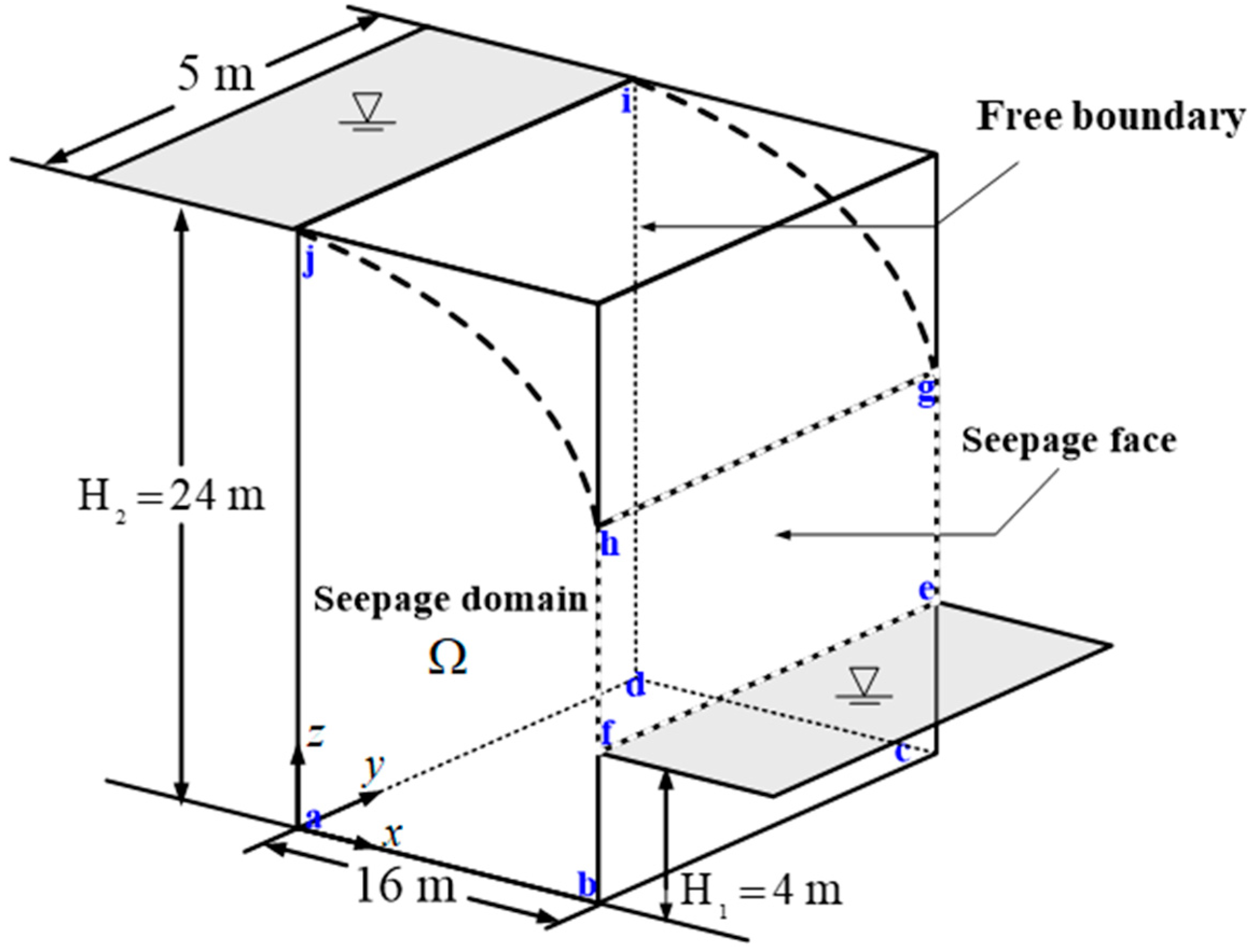
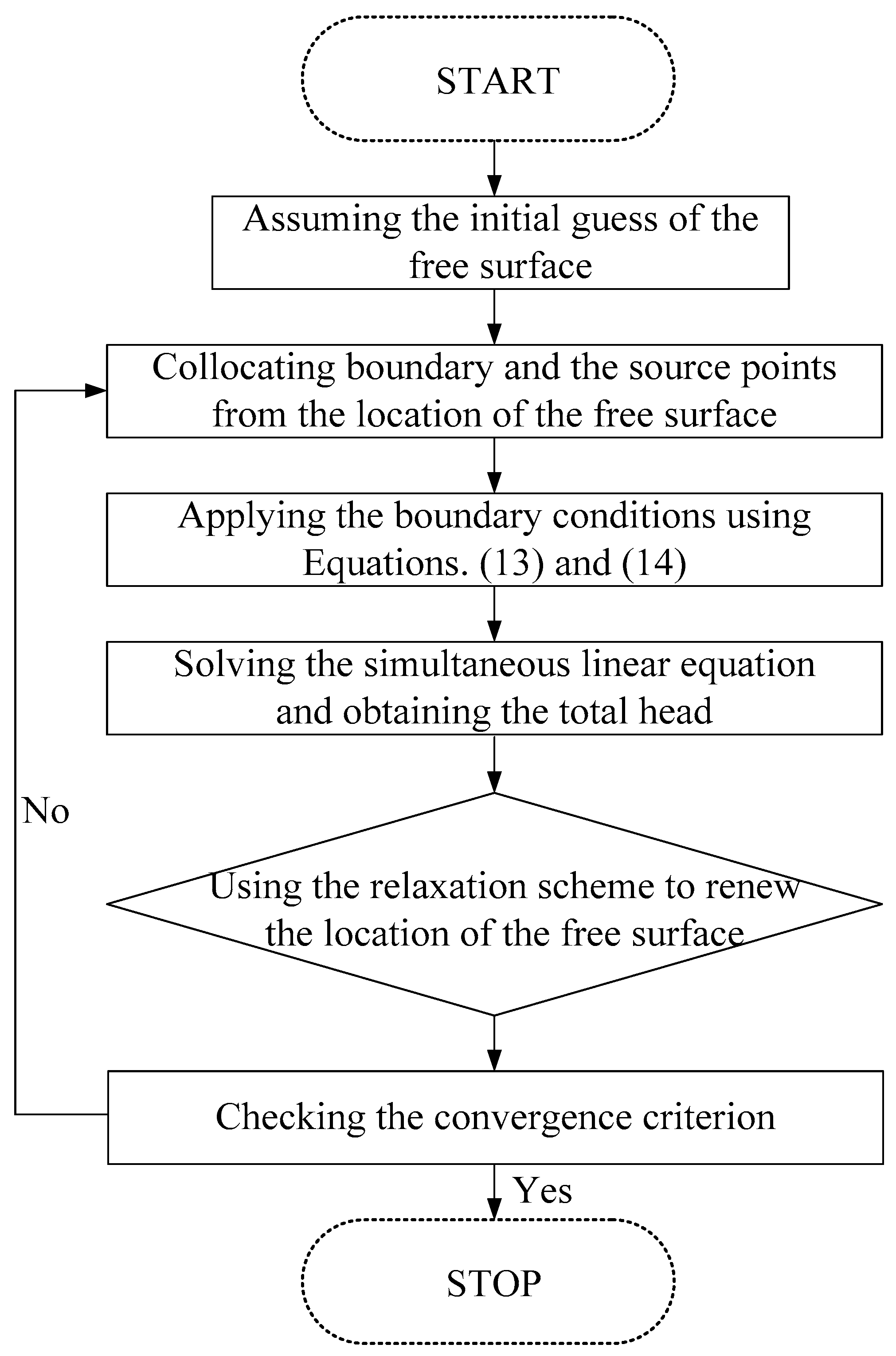
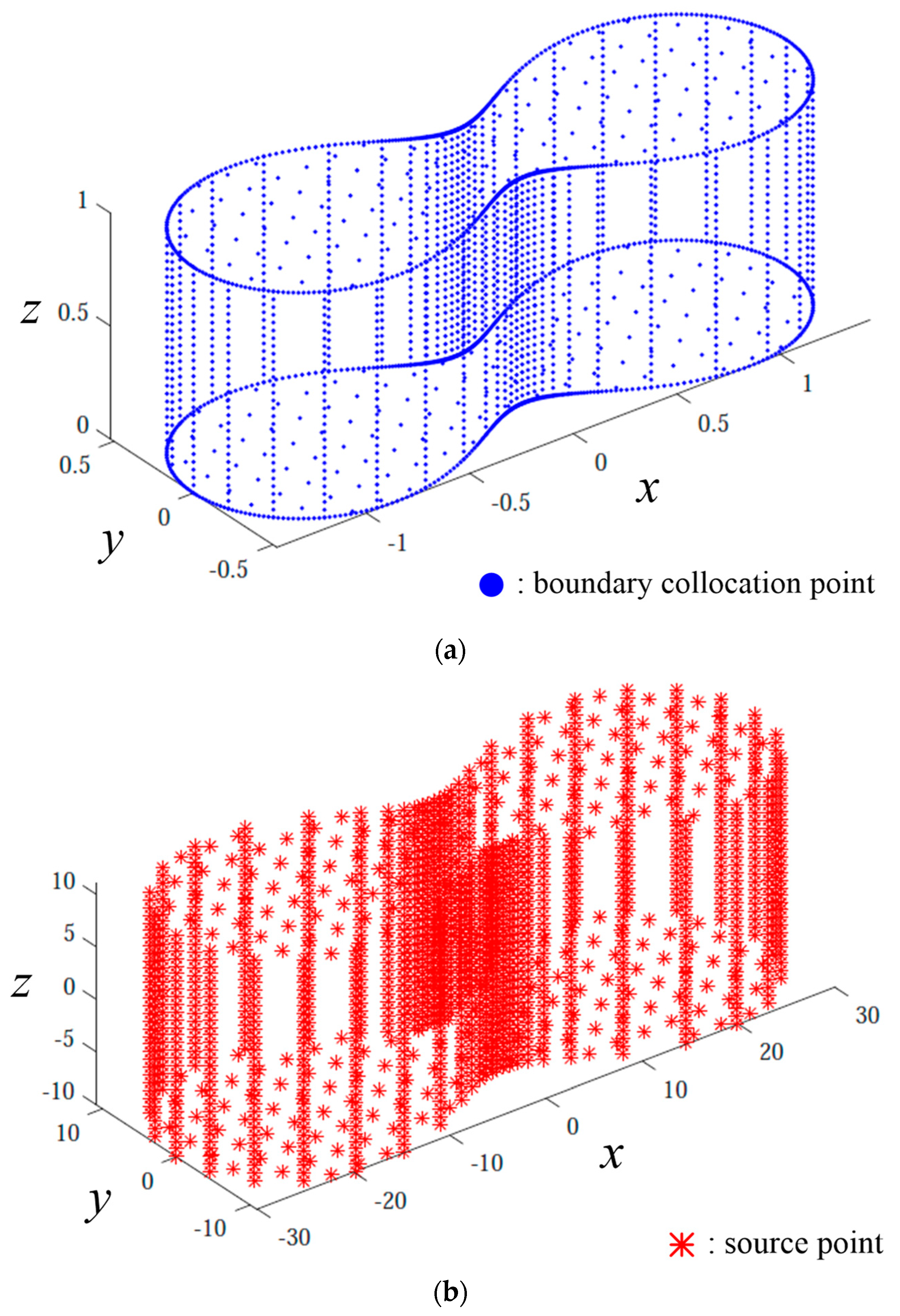
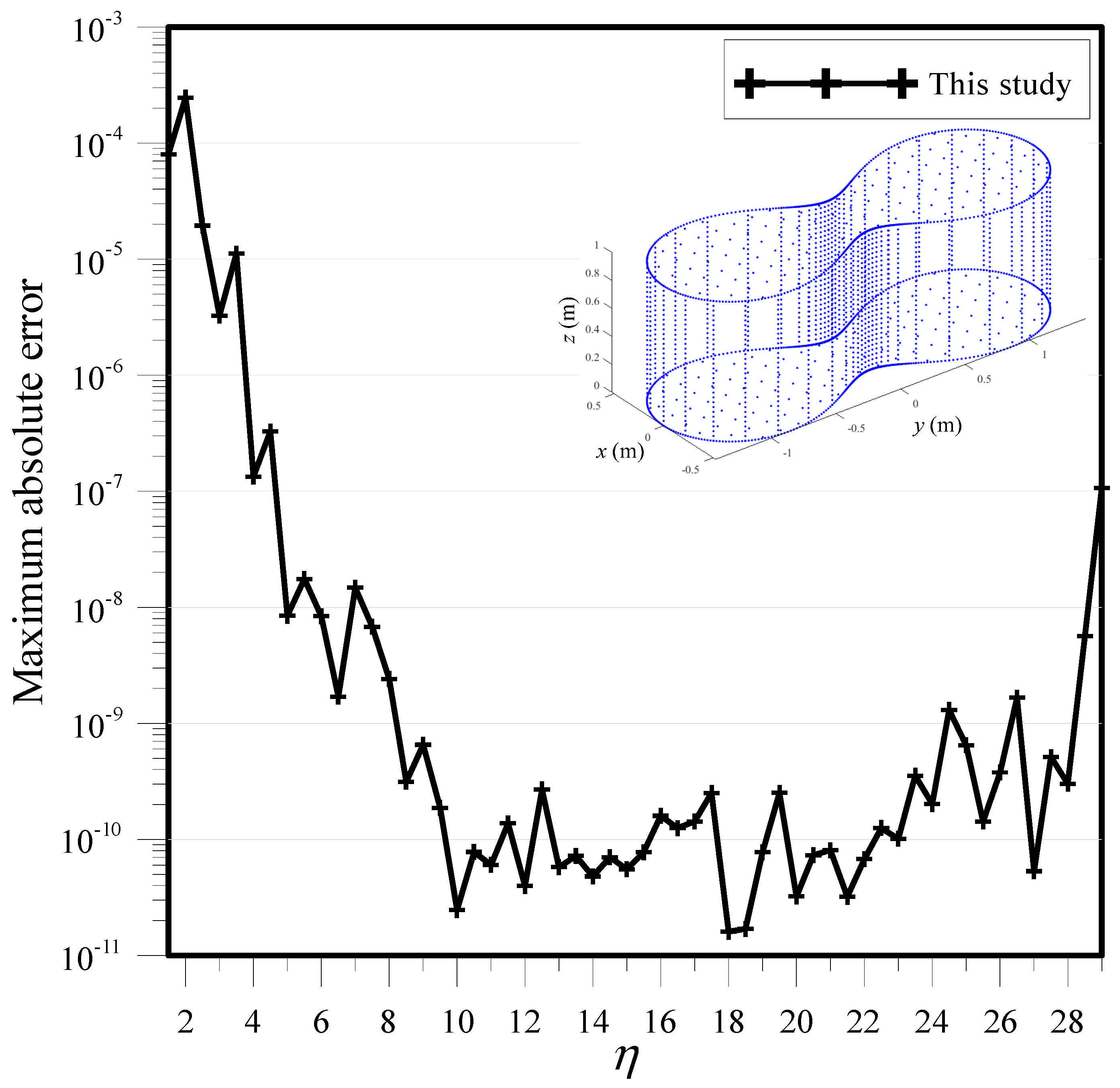
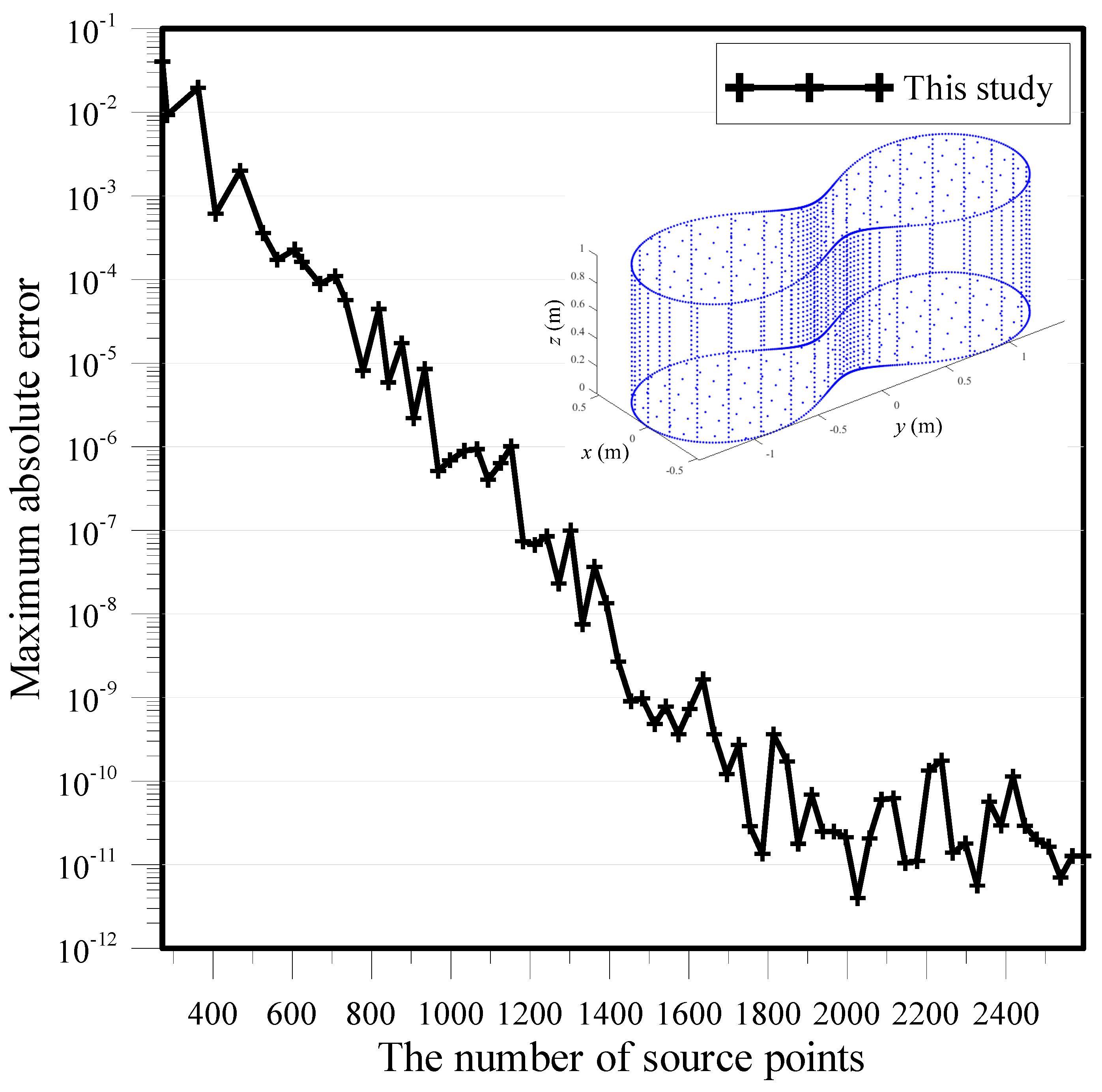
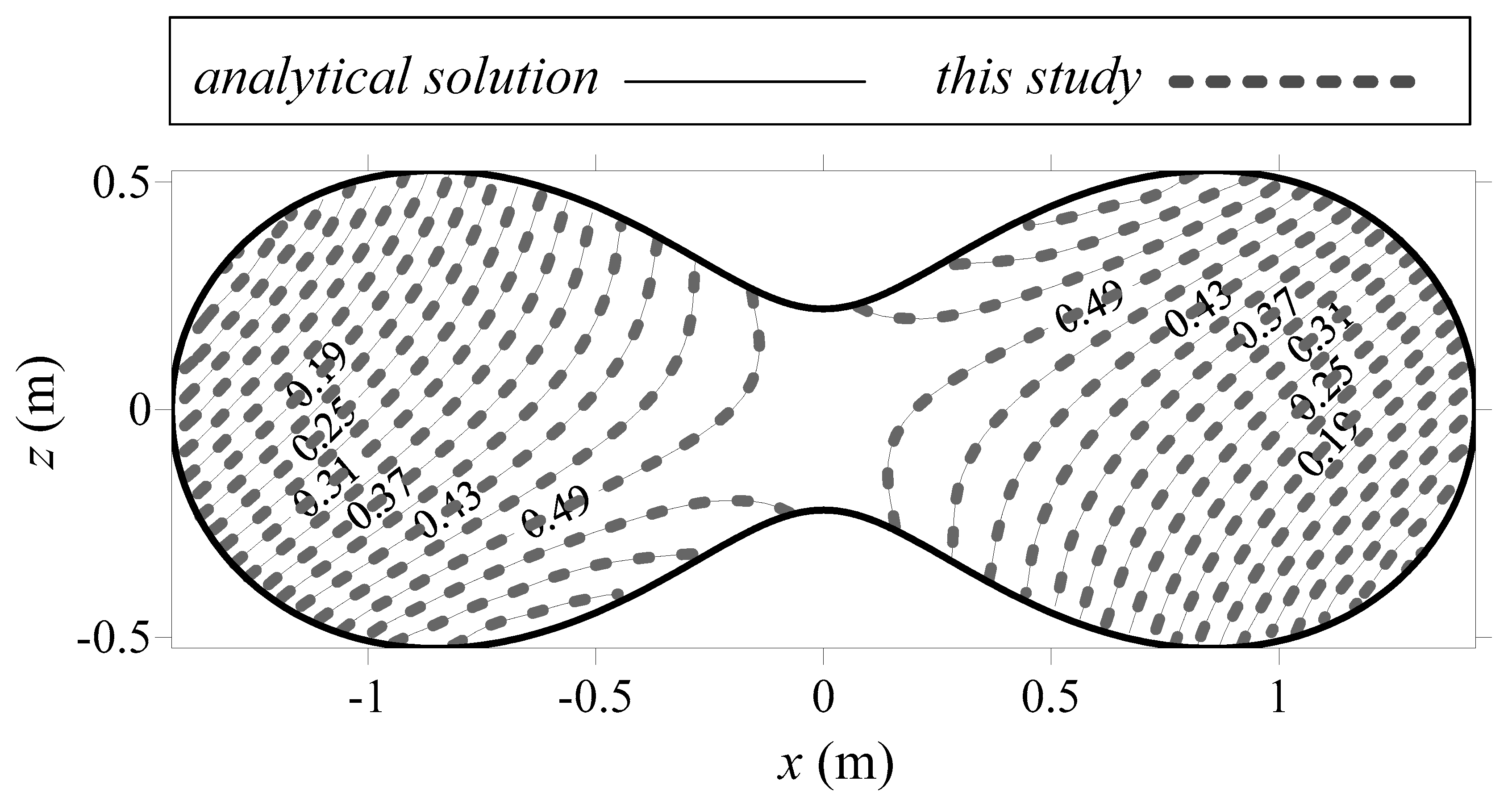
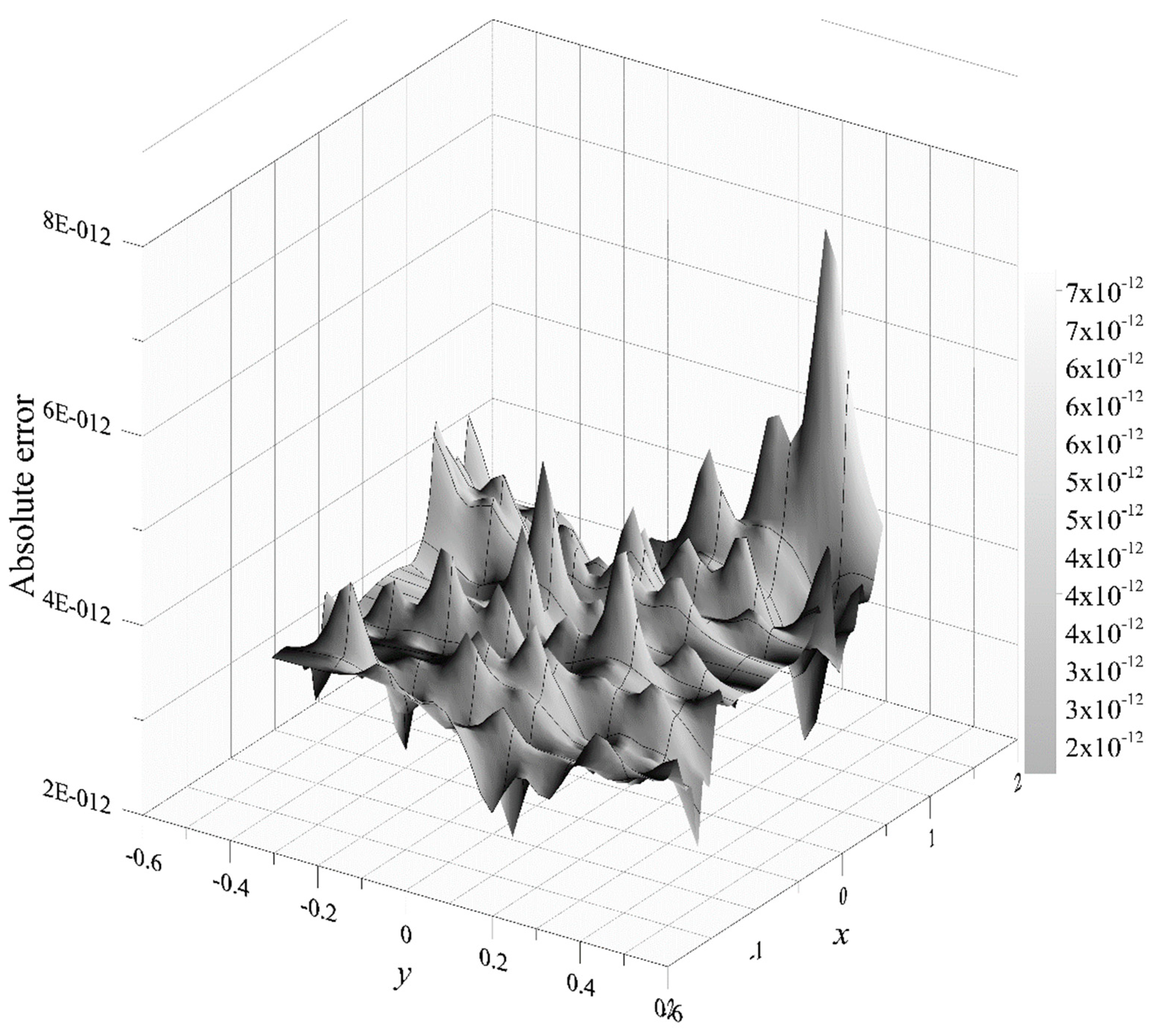
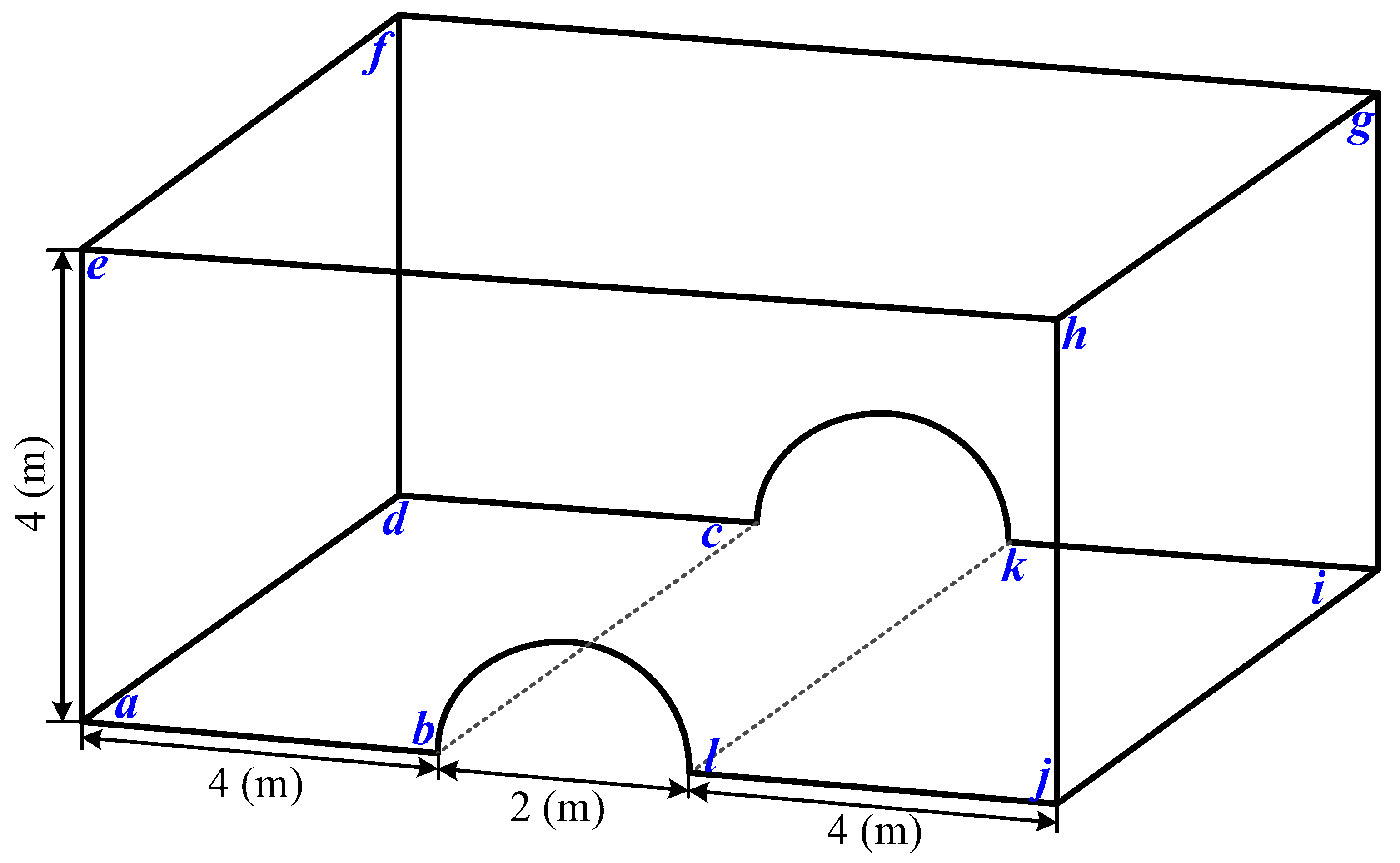
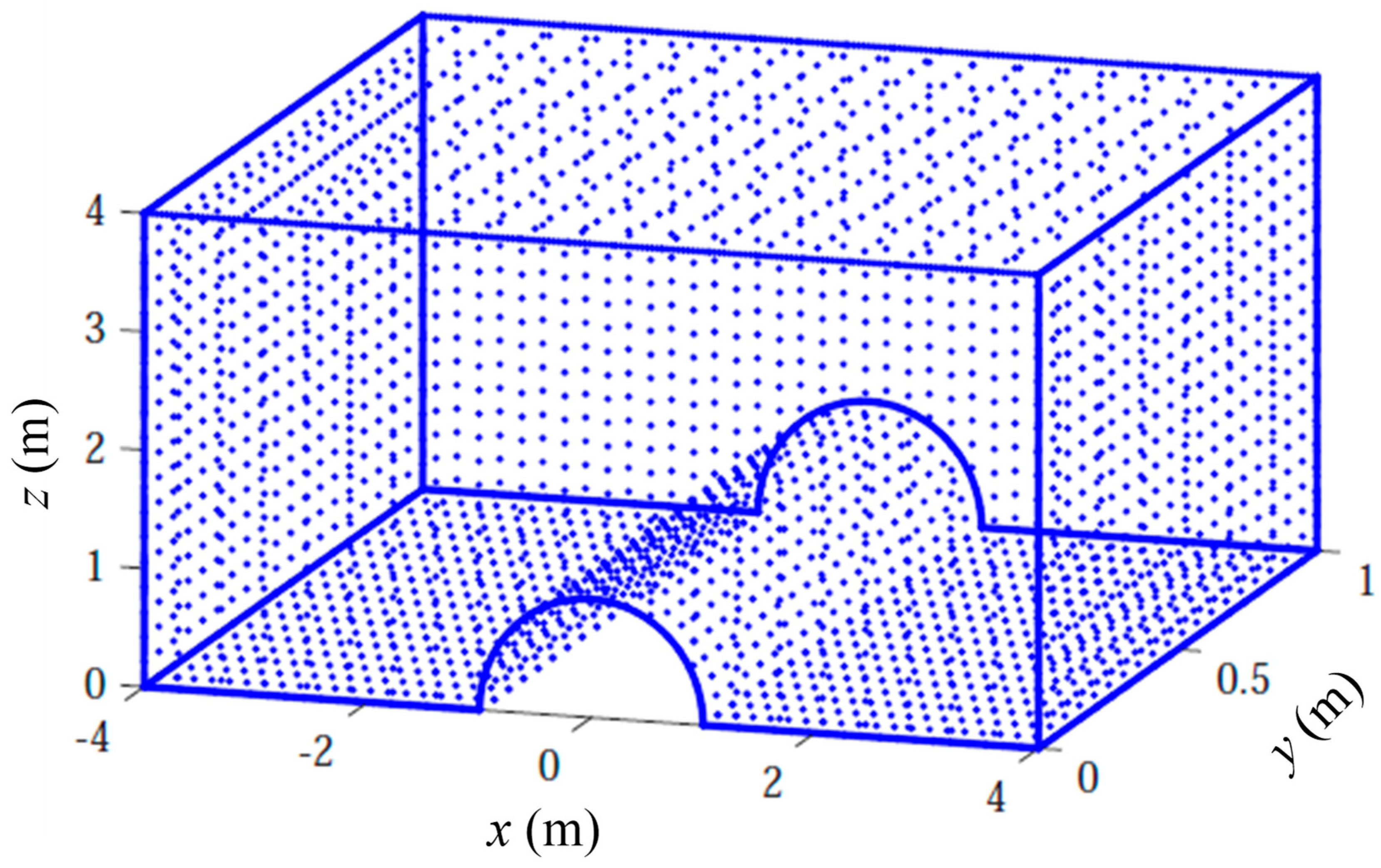
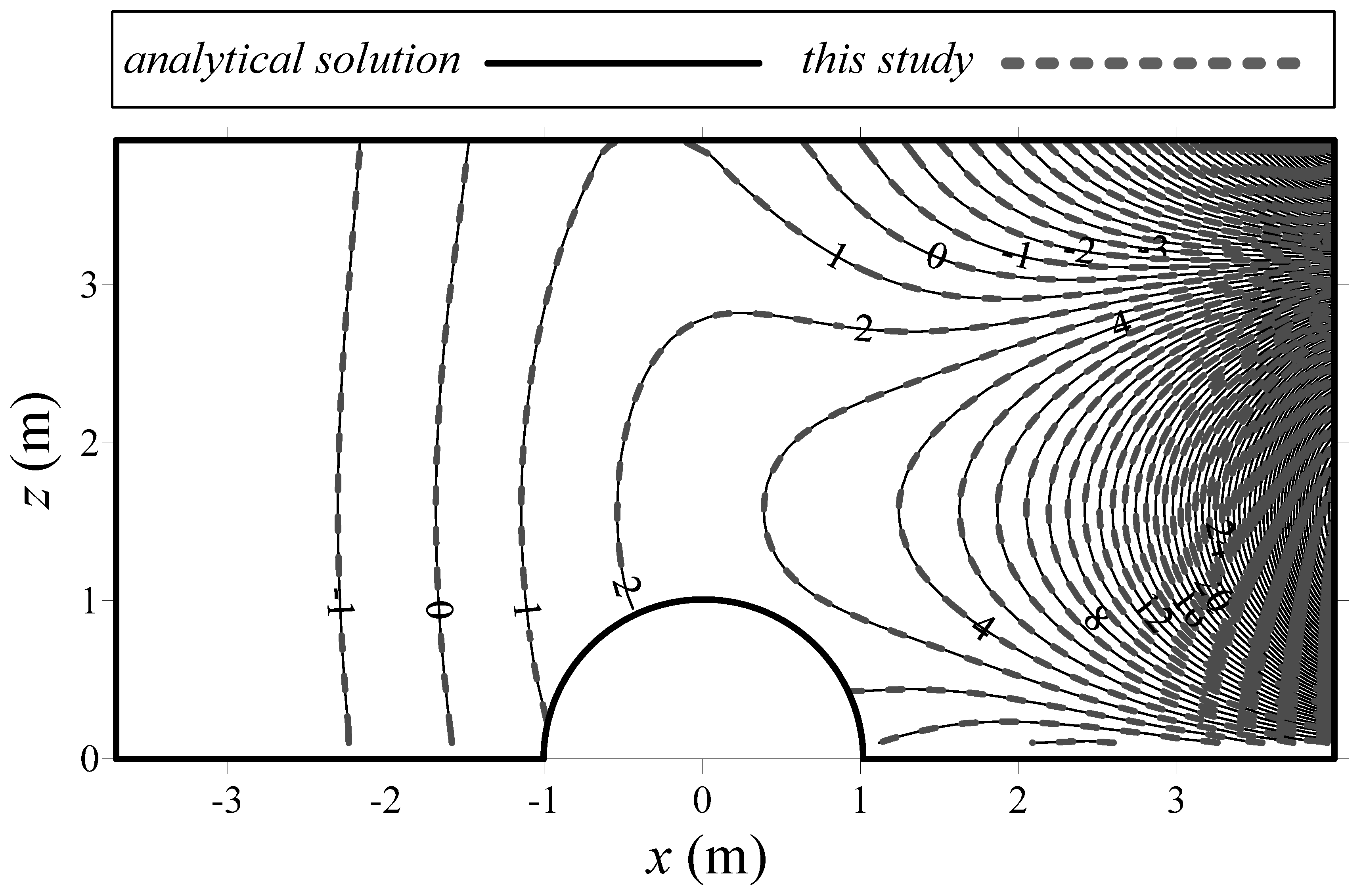
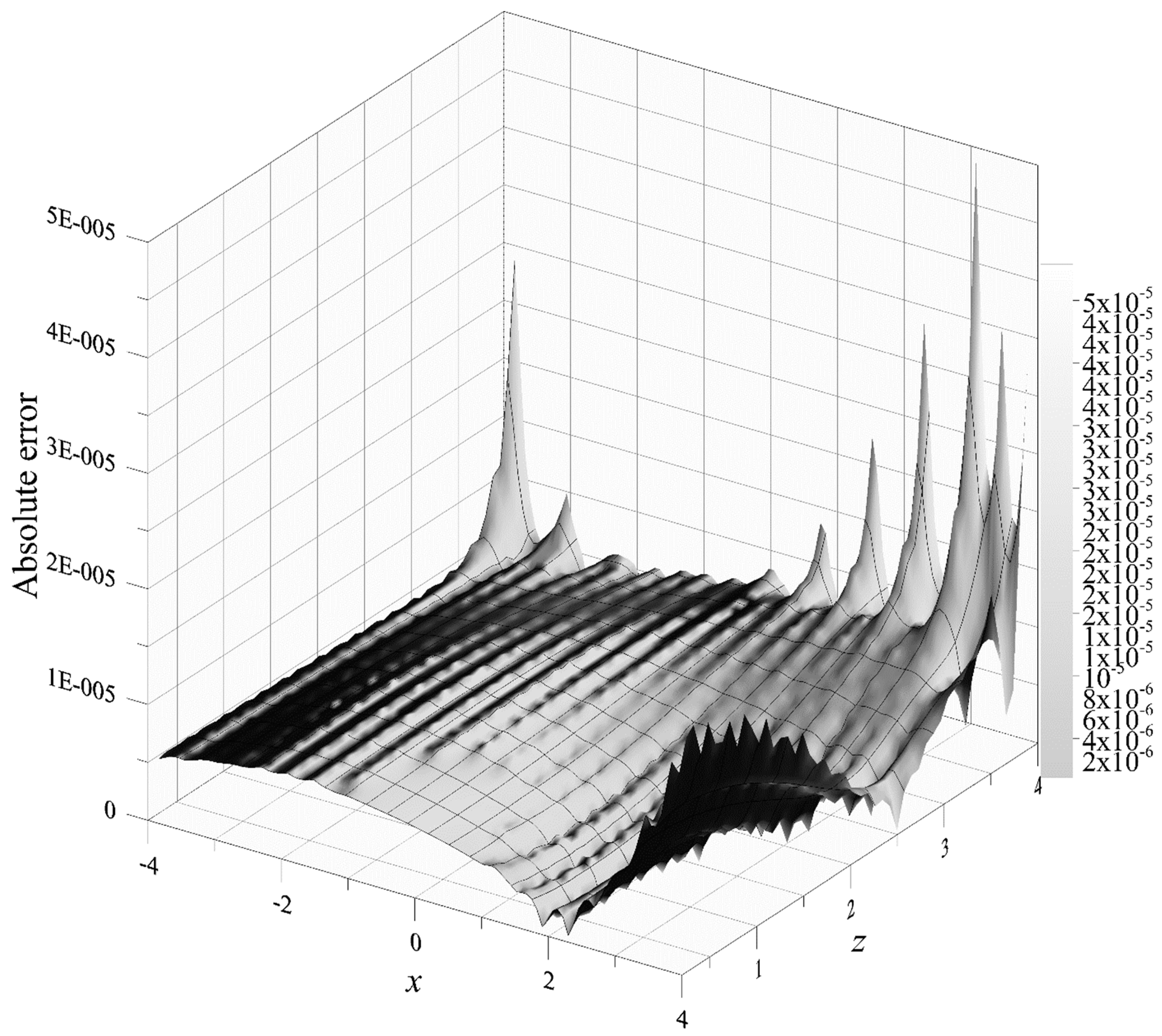
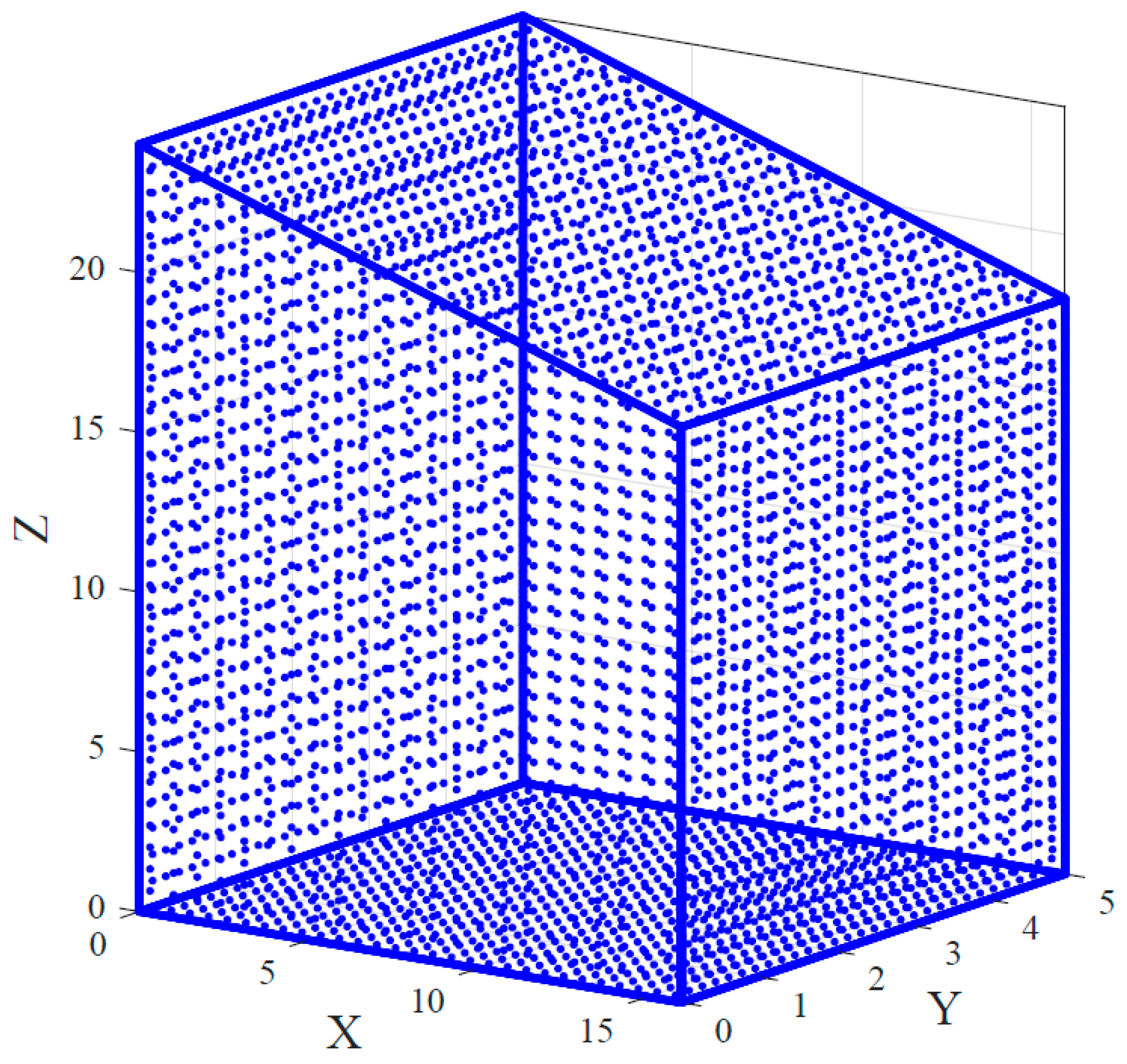
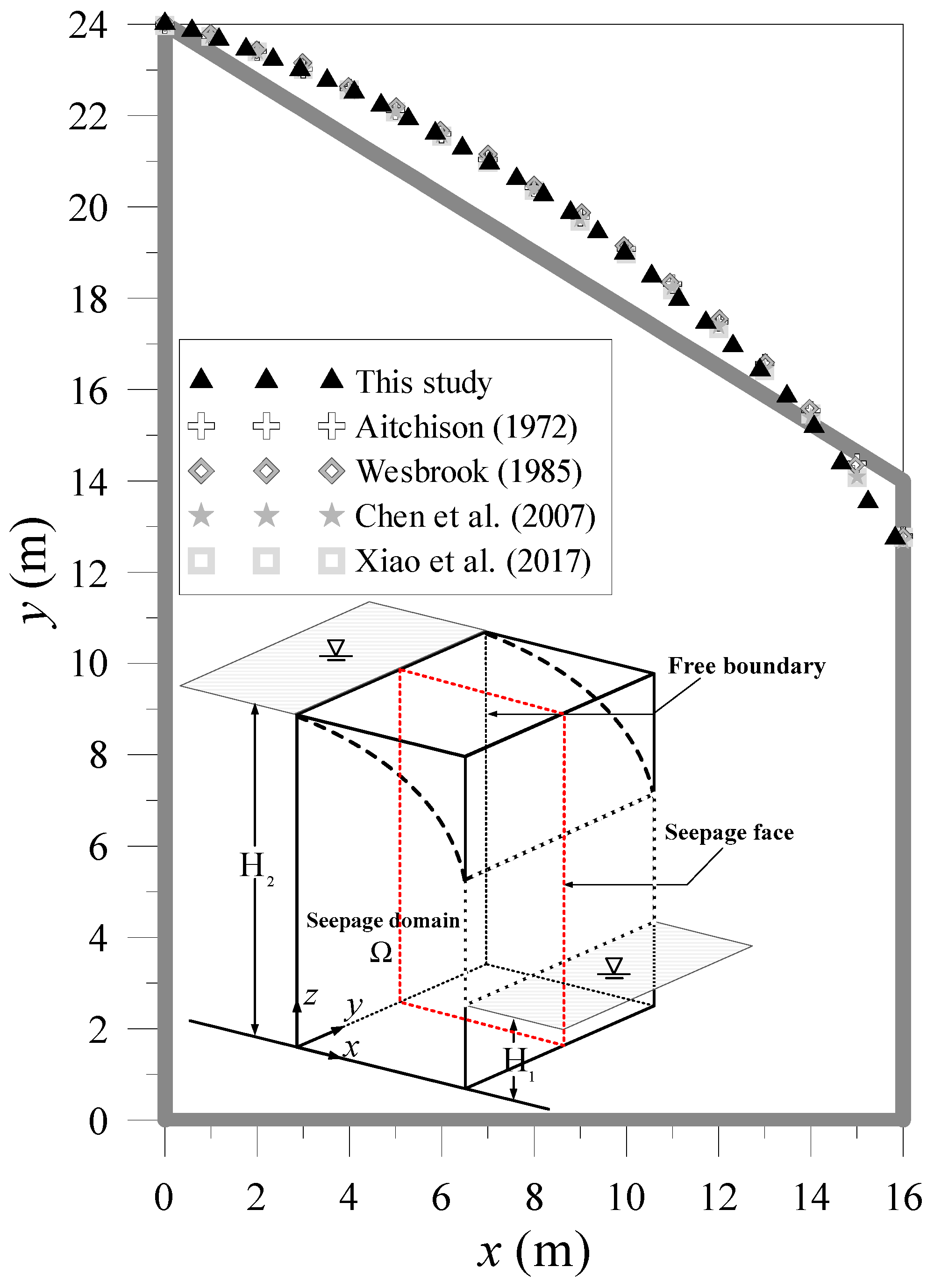

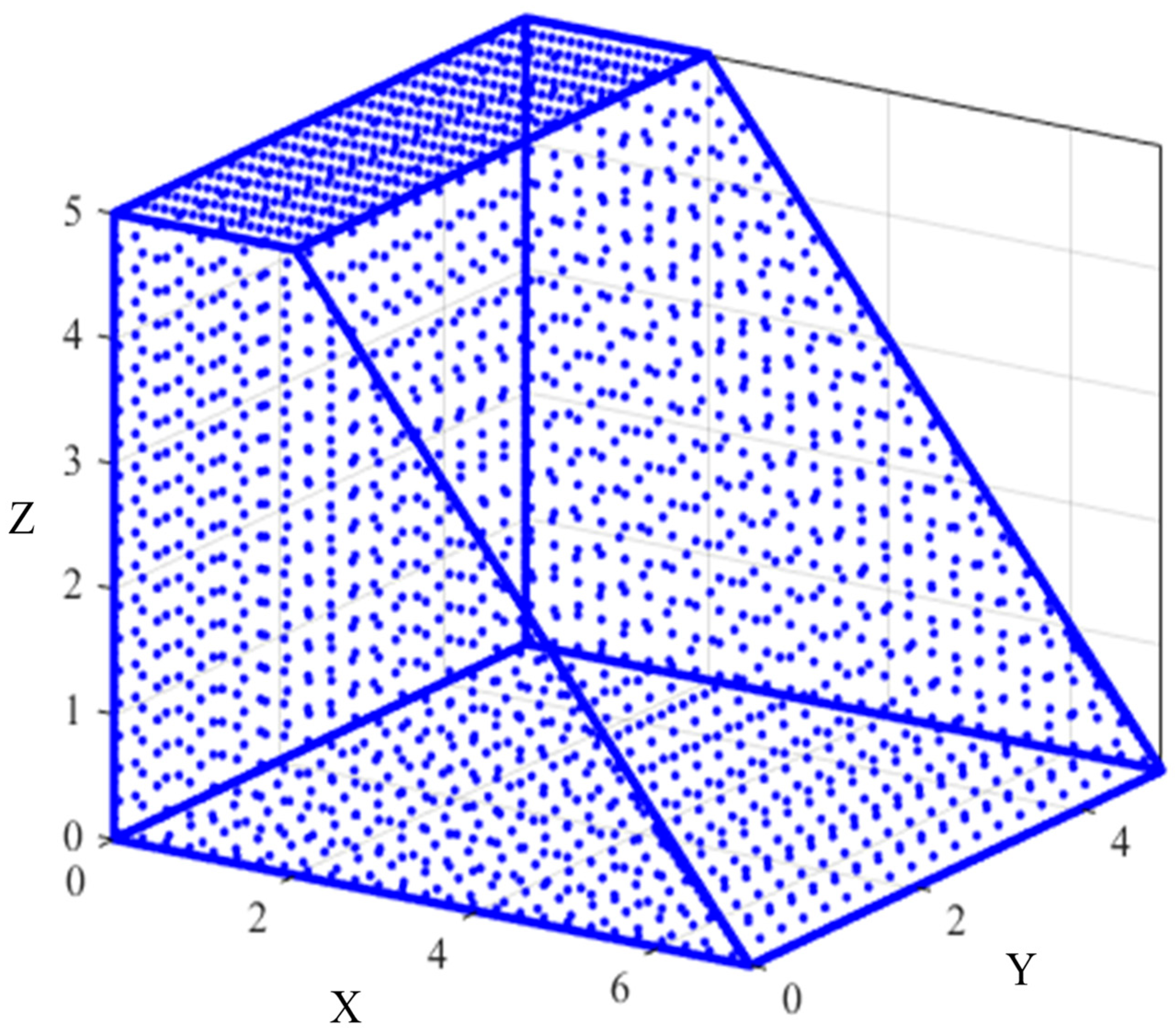
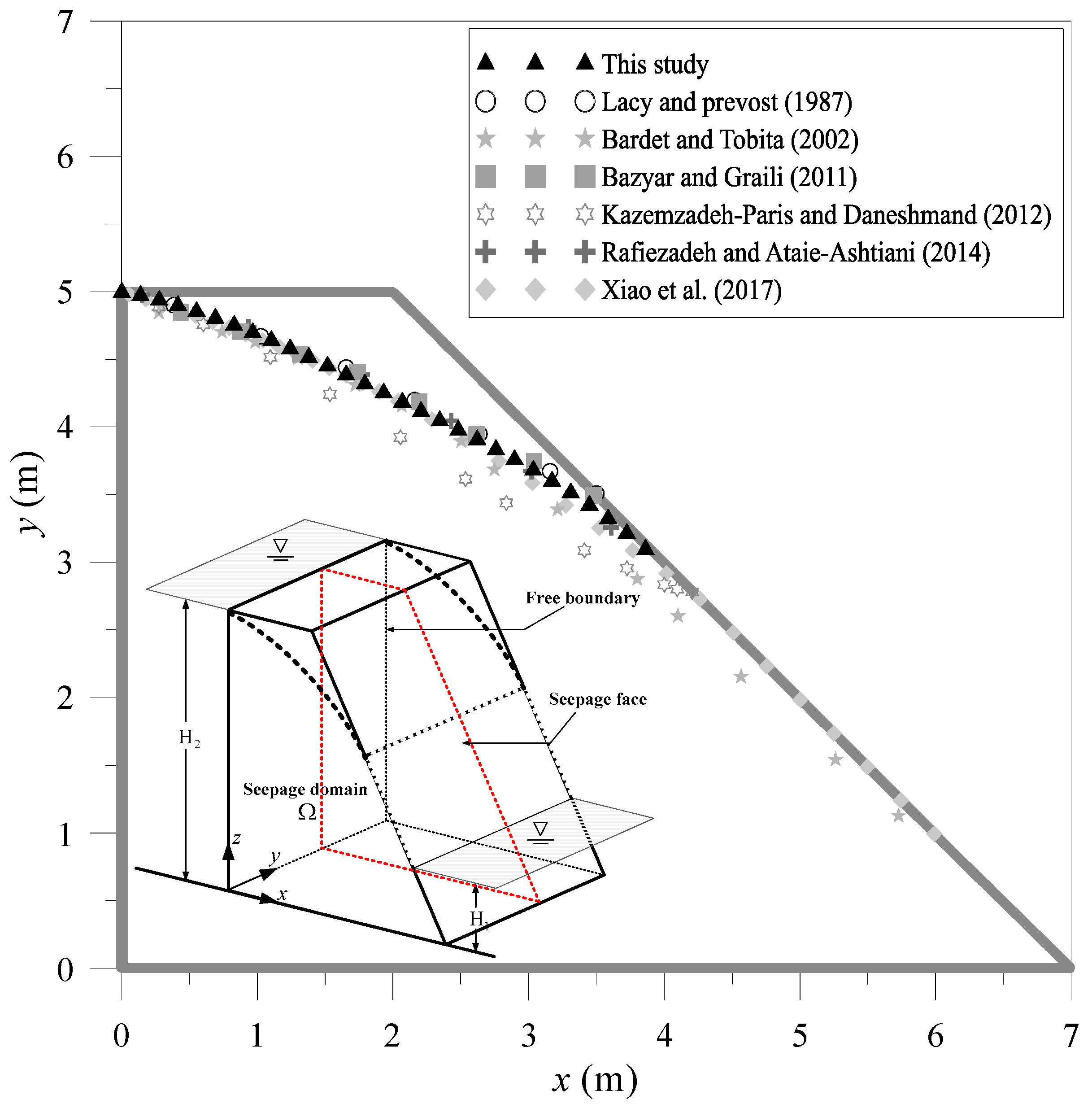

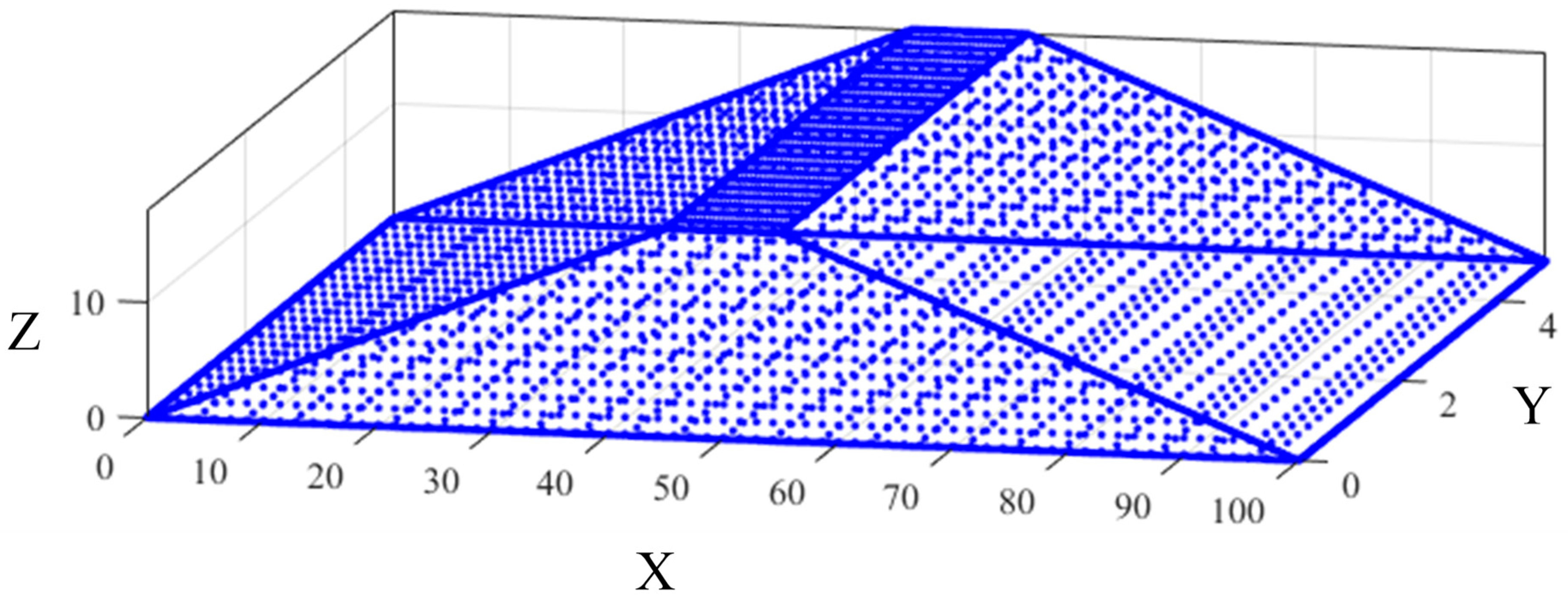
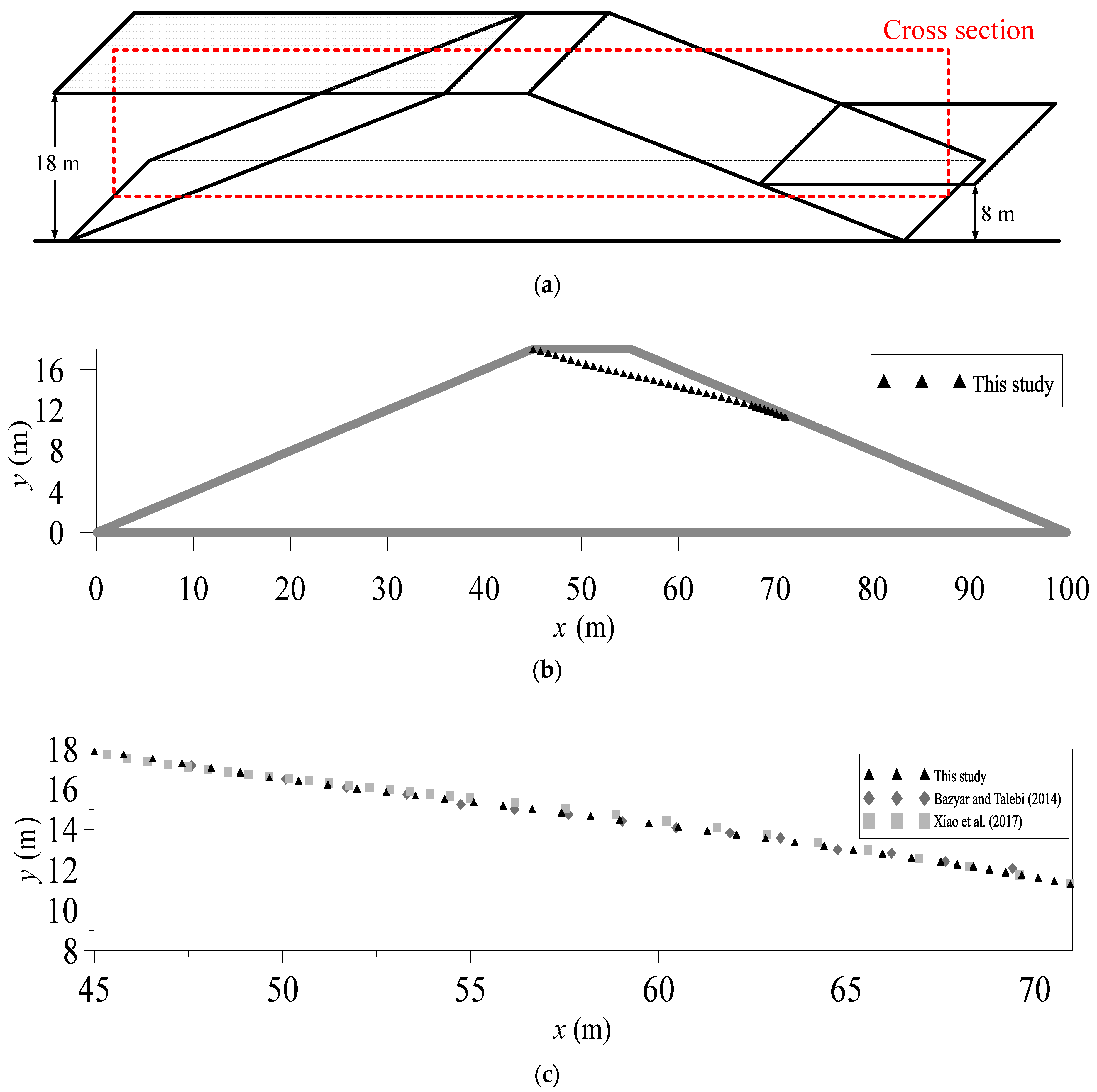
© 2019 by the authors. Licensee MDPI, Basel, Switzerland. This article is an open access article distributed under the terms and conditions of the Creative Commons Attribution (CC BY) license (http://creativecommons.org/licenses/by/4.0/).
Share and Cite
Ku, C.-Y.; Xiao, J.-E.; Liu, C.-Y. The Method of Fundamental Solutions for Three-Dimensional Nonlinear Free Surface Flows Using the Iterative Scheme. Appl. Sci. 2019, 9, 1715. https://doi.org/10.3390/app9081715
Ku C-Y, Xiao J-E, Liu C-Y. The Method of Fundamental Solutions for Three-Dimensional Nonlinear Free Surface Flows Using the Iterative Scheme. Applied Sciences. 2019; 9(8):1715. https://doi.org/10.3390/app9081715
Chicago/Turabian StyleKu, Cheng-Yu, Jing-En Xiao, and Chih-Yu Liu. 2019. "The Method of Fundamental Solutions for Three-Dimensional Nonlinear Free Surface Flows Using the Iterative Scheme" Applied Sciences 9, no. 8: 1715. https://doi.org/10.3390/app9081715
APA StyleKu, C.-Y., Xiao, J.-E., & Liu, C.-Y. (2019). The Method of Fundamental Solutions for Three-Dimensional Nonlinear Free Surface Flows Using the Iterative Scheme. Applied Sciences, 9(8), 1715. https://doi.org/10.3390/app9081715







